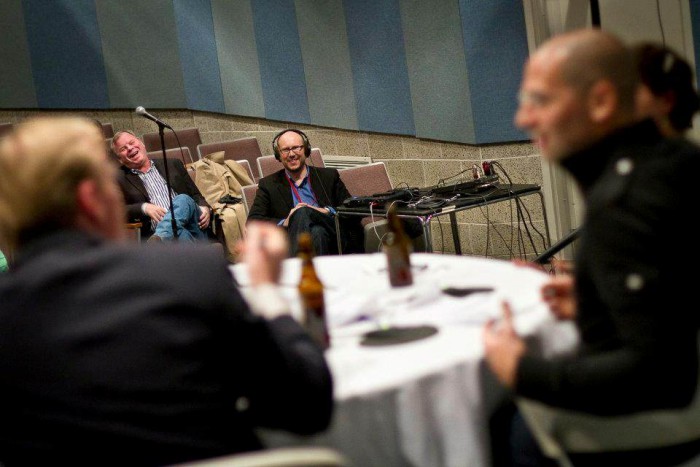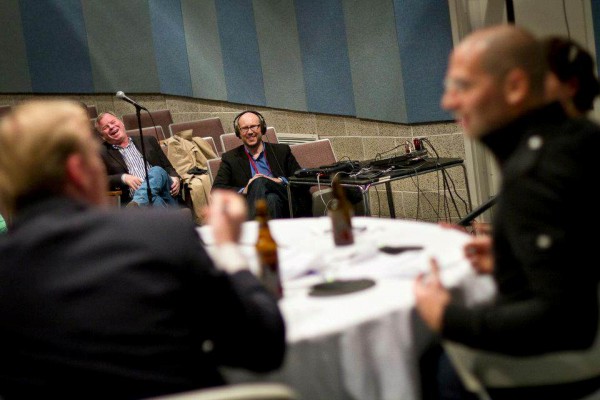

The New York Times started making podcasts way back in 2004, when the form was barely more than a concept and the term itself was new. In December 2011, the Times dropped nearly all of them, saying, in an opaque statement, “there may be other venues and programs that may be more advantageous in connecting with our audience.”
And then Boston Globe editor Marty Baron tweeted: “We dropped podcast years ago. Big time commitment, little gain.”
Are podcasts on the way out?
“We just all laughed at that,” said Andy Bowers, Slate’s executive producer of podcasts. Bowers, a 20-year veteran of NPR, came to Slate in 2003.1 He has created every one of Slate’s 19 podcasts, including four new ones in the last year. Three more are in the planning phase.
Podcast downloads now top 1 million a month, Bowers said, almost double the numbers from 2010. Hundreds of people show up for live tapings of the podcasts and pay for tickets. And they’re apparently a big hit with advertisers, who pay higher rates to advertise in Slate podcasts than any other kind of content.
So the Times announcement was a head-scratcher. “We thought, really? This isn’t working for you?” Bowers said. “Because for us it really is the part of Slate that people are absolutely most engaged with.”
Slate’s first podcast, the weekly Political Gabfest, remains its most popular. That show spawned the Culture Gabfest, in 2008, Slate’s second most popular. Bowers had the idea for the Gabfest almost seven years ago.
“I would listen to our Slate editorial conference calls, where people just love to throw out ideas and debate them and argue about them, and they were really funny and fun and insightful,” Bowers said. (It must have been a sea of counter-intuitive Slate pitches!) “I thought, you know, if I could just capture this in a podcast, I think people would [find it] really interesting. It would be like the discussion the political reporters have at the bar.”
Stephen Colbert is among the Gabfest’s most loyal fans.
Today, about 375 episodes later, Bowers said downloads typically reach five to six figures per episode. What makes it work is not a groundbreaking format but an expertly arranged mix of personalities: editor David Plotz and writers Emily Bazelon and John Dickerson have an infectious rapport. (And they love to do it. To cancel one of these shows, Bowers said, he “would have to pry the microphones out of their cold, dead hands.”)
The Gabfest counts among its fans Stephen Colbert, so loyal a listener he once phoned Plotz to ask why the hell a particular episode was late getting out. (I confirmed this with Colbert.)
Today Slate’s slate of podcasts includes Hang Up and Listen, a sports show; Lexicon Valley, a language show; and Manners for the Digital Age, hosted by Slate’s tech columnist and its advice columnist.
A big hit with listeners was Negotiation Academy, a limited-run podcast that ran for 10 episodes. Jill Barshay and Seth Stevenson offered lessons for negotiating in real-life situations — rent, salary, cars, children. That podcast was more like an audiobook, a nutritionally dense show that covered a single topic. Bowers said he’s developing concepts for similar shows.
Slate podcasts have ballooned not only in number but in length. The Gabfest was originally 15 minutes, the longest Bowers thought listeners could take. But listeners kept writing in and asking for the podcasts to be longer, then longer still. Now most programs are about 45 minutes long.
“Where else on the Internet do people go and seek out something that’s 45 minutes long and listen to it week after week after week, year after year?” Bowers said. “That kind of engagement is pretty extraordinary.”
That kind of engagement is what appeals to advertisers, said Slate publisher John Alderman. He would not tell me how much money Slate makes from podcasts but that “it is definitely a profitable part of the business.”
Slate charges a higher ad rate for podcasts than for any of its other content. And Slate podcasts have the highest sell-through rate; that is, Slate sells fills a higher percentage of its ad slots in podcasts than in story pages or videos.
“What we found, and what the advertisers found, is it’s incredibly powerful when the person is speaking to you, whether you’re in the car or making dinner,” Alderman told me. “The conversational tone of podcasts and especially the Slate podcasts make it a truly personal connection.”
The model is not unlike commercial talk radio, or television newscasts of the 1950s. Hosts drop sponsored product mentions into the middle of conversation. They are encouraged to describe their personal experience with the product. Because the ads fit no particular formula, they are hard to tune out.
Listen to how Plotz drops in this ad for GoToMeeting, between topics:
“The podcast is incredibly intimate, people connect with us deeply,” Plotz said in a live taping of the Gabfest last month in New York. “And they connect with Slate because they like spending time with us on the show.”
Plotz tells me he has been stopped “tons of times” by passersby who identify him by the sound of his voice.
So why didn’t podcasts work for The Boston Globe or The New York Times?
In an email, I asked Baron to explain that tweet:
We had a few podcasts related to the news. Each podcast required a few hours of staff time every day — to review the stories, write the script, record it. While the listeners seemed satisfied and very devoted to the podcast, the numbers weren’t big. So, when we had to review how to spend our money, podcasts didn’t rise to the top of the priority list. They were close to the bottom. Still, if Slate is now having great success, we’d take a look at it and see [if] there are opportunities for equivalent success here.
The Times and the Globe are general-interest publications with different audiences. General interest may not work so well in podcasting, where listeners have so much choice.
“I think what the Times did is, they made a choice,” Bowers said. “They could have done front-page style or op-ed page style. And they chose front page. And I think that was the wrong choice for podcasting. I think opinion and criticism and personality are important in podcasting, and they chose not to do that. In the political one, they said ‘Mr. Obama’ and ‘Mr. Romney,’ and I think that’s a little too formal for the medium.”
The Times’ two remaining podcasts are Book Review with Sam Tanenhaus and Science Times with David Corcoran. Both are highly produced, with music, billboards (introductions that tease upcoming segments of the show), and recorded interviews. Slate’s Gabfests require little editing, Bowers said, making them efficient to produce. It sounds like the host turns on the microphone and starts talking — and that’s pretty much what it is.
Bowers did virtually everything you can do in radio during his time at NPR: London bureau chief, Moscow bureau chief, White House correspondent, media correspondent. He oversaw the innovative collaboration between Slate writers and Day to Day, NPR’s erstwhile midday magazine.
“Coming from radio, where real estate on the air is incredibly valuable — I look at the Internet as a great place to experiment and try things,” he said. And the next frontier for podcasts? The car.
“I have a Ford that has a Bluetooth connection to the phone. I get in the car and I start listening to the podcast, and I get to the store and it pauses. And then I get in and it picks up again,” he said. “It’s even easier than TiVo, because you don’t have to remember to set the timer.”
Photo of Andy Bowers (center) at a 2011 live taping of Political Gabfest courtesy of Grinnell College. Foreground, left to right: John Dickerson, David Plotz, Emily Bazelon.